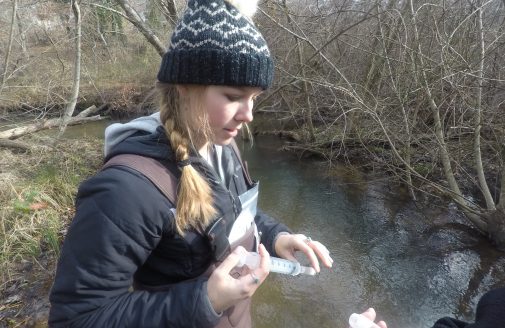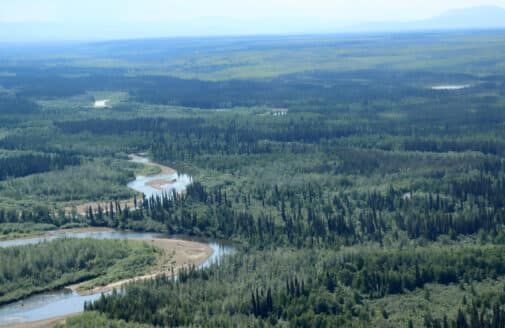Riparian forests stand guard over Amazonian streams
A strip of riparian forest runs through an agricultural field in Brazil.
photo by Christopher Neill
In the remote headwaters of the Amazon, a small strip of forest—just 30 meters wide on either side of a stream—slices through a vast agricultural field. Although tiny, this forest stands as an important guardian of the health and biodiversity of the Amazon Rainforest.
In many places, riparian forests along the edges of streams and rivers are the last remaining forests on a landscape largely converted to agriculture. Brazil’s forest code requires a permanent protection area be left on the banks of waterways to buffer the effects of land use change on downstream ecosystems. But how effective are such small slivers of forest in the face of widespread landscape change? A trio of papers from Woodwell’s Tanguro Ranch research station in Mato Grosso, Brazil shows that even small forests can have big impacts on biodiversity and nutrient transfer.
Maintaining the ecosystem highway
Rivers act as highways through the forest, carrying species, nutrients and organic matter across the landscape. Trees play an important role in regulating those roadways, both drawing up water and nutrients and depositing organic matter in the form of leaves, seeds, and fruit. Clear the forest, and the traffic patterns for those nutrients will change.
Dr. KathiJo Jankowski, a research ecologist at the United States Geological Survey, conducted research with Woodwell on the question of whether maintaining riparian buffers successfully mitigated that change.
“Are streams now processing terrestrial materials differently? Are they processing carbon differently? And are they processing nutrients differently?” Dr. Jankowski asks. “We are interested in these questions, both in terms of how they affect stream food webs, and how they affect downstream ecosystems.”
She waded through the streams at Tanguro Ranch, collecting data—dissolved oxygen levels, leaf litter, temperature measurements—to answer these questions. When she compared data from agricultural streams with riparian buffers to intact forests, she found only subtle shifts in basic ecosystem functions. As long as those buffer forests remained, the streams mostly continued to flow as they always had.
“It provides good evidence that they are doing their job,” Dr. Jankowski said. “It highlights the importance of protecting those buffers because they are constantly under threat from people wanting to develop the land or simply not wanting to restore buffers that have been illegally removed.”
Preserving aquatic and terrestrial diversity
One difference Dr. Jankowski did observe, however, was in the amount of leaf litter present in the streams. Less overall vegetation on the landscape led to less organic matter in agricultural streams, a small change that can impact the wider food web.
Ecologist and researcher from the University of Brasília, Dr. Nubia Marques was conducting complementary research around the same time as Dr. Jankowski, but her research focused on the animals that rely upon the ecosystem functions Dr. Jankowski was studying. Tiny macroinvertebrates—crustaceans or insects that feed on stream organic matter—are found in most aquatic ecosystems, and their presence can indicate the overall health of a system.
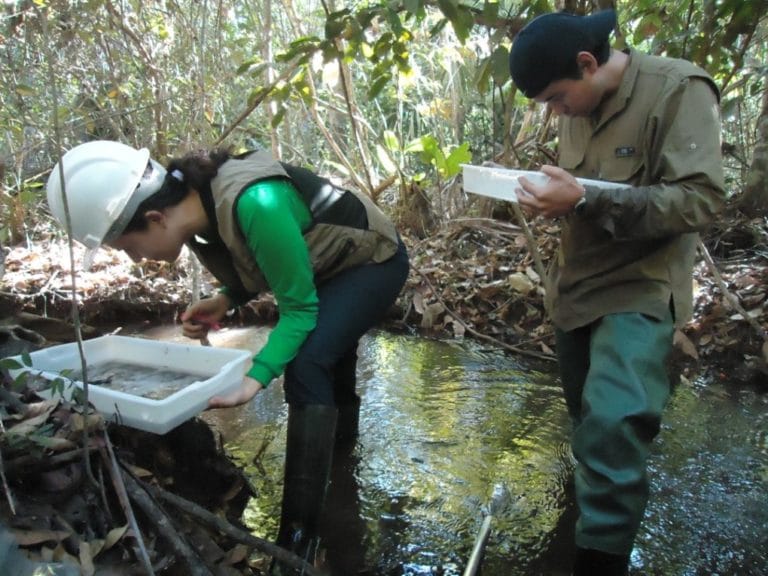
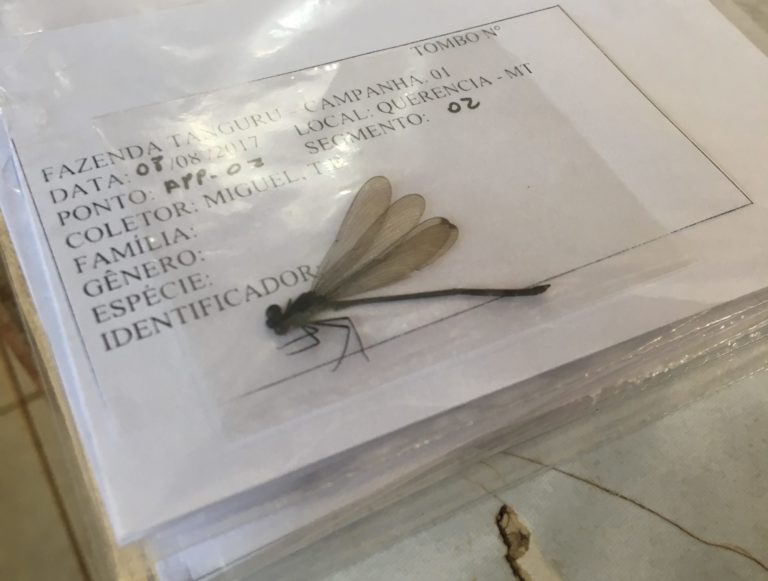
Left: Dr. Marques and Tiago Kisaka collect and identify macroinvertebrates.
Right: Many common insects, like this damselfly, start their life cycles as larvae living in streams.
photos by Paulo Ilha and KathiJo Jankowski
According to Dr. Marques, degradation of riparian forests tends to simplify macroinvertebrate communities. Changes to available food resources impact species that rely on specific food more strongly than generalist species. Three taxonomic orders, Ephemeroptera, Plecoptera and Trichoptera (EPT) which include species like mayflies, stoneflies, and caddisflies, are particularly sensitive to disturbances.
“Many macroinvertebrates in the EPT orders cannot survive in sites of intense disturbance, so their absence may indicate that the health of the stream is not doing well when compared to similar streams that have not been disturbed at all,” Dr. Marques says.
Dr. Marques examined overall species composition, as well as functional composition (the presence of different feeding groups) across forested and agricultural streams. Streams with buffers tended to have greater overall diversity and slightly higher abundance of EPT species than those without, though watershed-level clearing did cause drops in EPT species with or without buffers. Because macroinvertebrates form the base of the food web, changes in their abundance have the potential to ripple upwards to the species communities that feed on them.
Beyond preserving biodiversity inside the streams, riparian forests are also important habitat for terrestrial rainforest species. Biologist at the State University of Mato Grosso and researcher at the Amazon Environmental Research Institute, Dr. Leonardo Maracahipes-Santos conducted detailed inventories of the size and species of trees, shrubs and vines in each of the transects to understand how the riparian forests themselves differed between intact and agricultural watersheds.
The team at Tanguro measured the size and species of trees and other vegetation in the riparian zone.
photo by Leonardo Maracahipes-Santos
“There are some visible differences, that if you know the species you can see right away,” Dr. Maracahipes-Santos says. “One difference I noted was that in the agricultural riparian forest you tend to see more gaps. Also there are some species along the edges that are known to be pioneer species, they signal some level of degradation or turnover.”
His analysis confirmed his observations. Riparian forests tended to differ most from the composition of intact forests at the edges, where niches had been opened for species that normally don’t occur in dense forest. Also, as seen with the critters in Marques’s study, some plant species were just not as resilient to disturbance and disappeared completely from agricultural landscapes.
Dr. Maracahipes-Santos’ work shows that, for all these little forests do, they themselves are vulnerable to the effects of fragmentation. Though the law establishes a minimum width for riparian forests, the amount of forest considered functionally intact may be much smaller, highlighting the need for wider buffers with softer edges leading into agricultural fields.
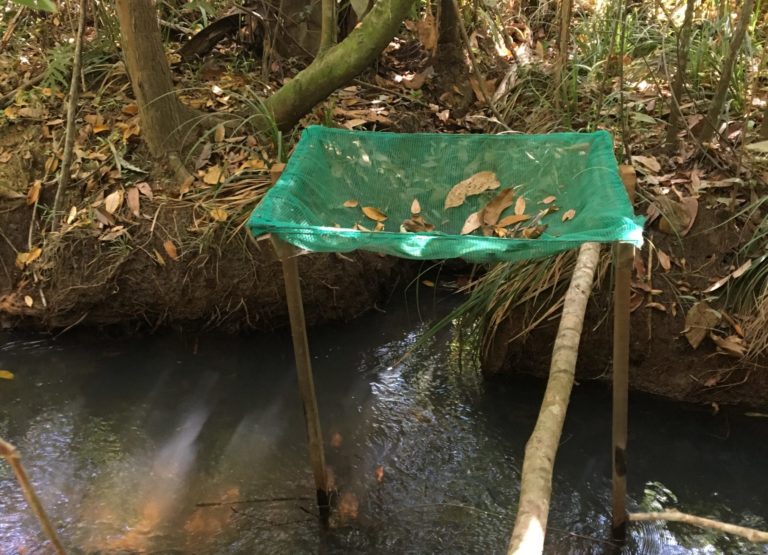
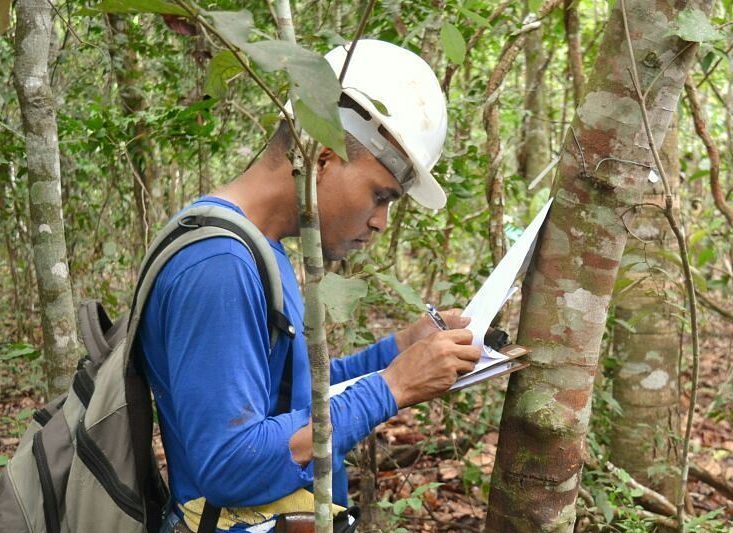
Left: Nets strung over the water collect samples of leaf litter.
Right: Dr. Maracahipes-Santos records data about trees in a riparian transect.
photos by KathiJo Jankowski and Domingos Lucas dos Santos Silva
Protecting the headwaters protects the landscape
The three studies together also revealed landscape-scale changes took place in streams despite the presence of buffers. Dr. Jankowski found agricultural streams tended to be warmer on average and received more sunlight due to increased gaps in the canopy. With fewer trees to draw up water, stream levels were higher in agricultural landscapes as well. This tracks with Dr. Maracahipes-Santos’ findings—species sensitive to soggy soil were harder to find in the riparian buffers on agricultural land.
Dr. Jankowski’s experiment also introduced nitrogen and phosphorus into the stream systems, mimicking a fertilizer runoff event, to track how far the nutrients would flow. Tanguro is situated at the headwaters of the Xingu River, a major tributary of the Amazon, which means that anything added to the watershed here has the potential to affect the larger system downstream. Dr. Jankowski found that nitrogen traveled far downstream regardless of buffers. Multiply the effects of one nitrogen plume across the thousands of headwater streams in the Amazon watershed, and the impacts could potentially extend all the way to the Atlantic.
Despite this, riparian forests remain an important line of defense against pollutants and biodiversity loss. They will play a growing role in linking and protecting the Amazonian watershed as agricultural clearing continues. To play this part successfully, they will need support and protection of their own.
Latest in Water
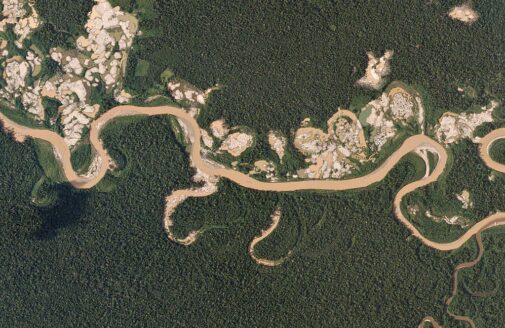
- In The News
Gold mining causes long-lasting damage in the Amazon rainforest
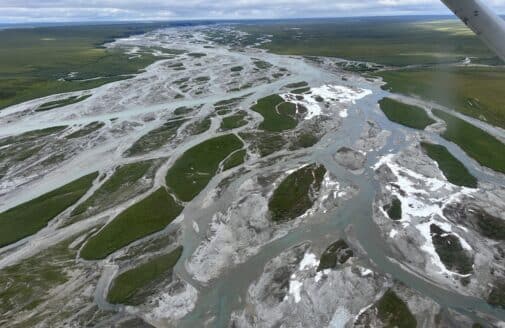
- In The News




